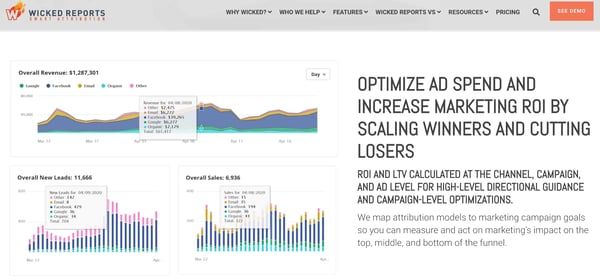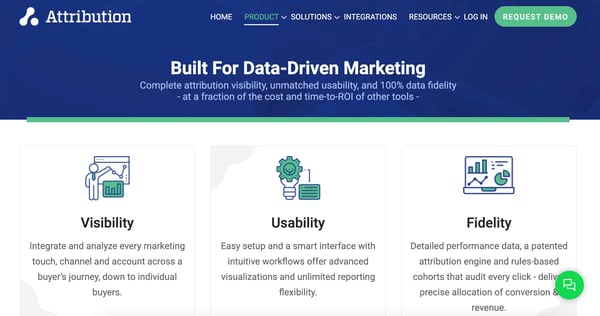As a marketer, you know how many avenues there are for your prospects and customers to interact with you throughout the buyer’s journey. These avenues refer to channels (e.g. PPC, your website, email campaigns, social media) and touchpoints (e.g. specific ads, blog posts, social media posts, emails). Marketing attribution modeling can help you determine the impact of all of those marketing efforts.
Attribution Modeling
In this blog post, we’ll talk about what attribution modeling is, why it’s important, the different types of attribution modeling, and some tools to help with the process. Let’s get started.
What’s the purpose of attribution modeling?
By assigning credit to your marketing channels and touchpoints, you can increase your chances of converting more prospects by 1) identifying areas of the buyer’s journey that you can improve, 2) determining the ROI for each channel or touchpoint, 3) surfacing the most effective ways to spend your marketing budget, and 4) tailoring your marketing campaigns and content to your unique personas.
Types of Attribution Modeling
There are a handful of common types of attribution modeling. Although all attribution models look at the channels and touchpoints involved in a customer’s decision to convert, each of them weighs those channels and touchpoints differently.
1. Multi-Touch Attribution Modeling
Multi-touch attribution modeling is powerful because it takes into account every channel and touchpoint that a customer interacted with throughout the buyer’s journey, up until they decided to convert. It tells you which of those channels and touchpoints were most influential as well as provides insight into how they worked together to influence a customer.
2. Cross-Channel Attribution Modeling
Cross-channel attribution modeling is often used interchangeably with multi-touch attribution. However, their definitions differ slightly. Cross-channel attribution designates value to each marketing channel (such as paid, organic, or social media) but doesn’t look at the specific touchpoints within those channels the way that multi-touch attribution does.
3. Linear Attribution Modeling
Linear attribution modeling is a type of multi-touch attribution that gives equal credit to all channels and touchpoints that a customer interacted with throughout the buyer’s journey.
4. First-Touch Attribution Modeling
First touch attribution modeling gives all the credit for the conversion to the first channel or touchpoint that was interacted with by the customer.
5. Last-Touch Attribution Modeling
Last-touch attribution modeling is the opposite of first-touch attribution modeling — it gives all the credit to the last touchpoint a lead interacted with before converting.
6. Time-Decay Attribution Modeling
Time-decay attribution modeling gives credit to all of the touchpoints that contributed to a conversion and also considers the time that each touchpoint occurred — the touchpoints that happened closest to the time of conversion are weighted most heavily.
7. U-Shaped Attribution Modeling
U-shaped modeling, also known as position-based attribution modeling, splits the credit for a conversion between the first and last touchpoints.
8. W-Shaped Attribution Modeling
W-shaped attribution modeling gives the most credit to the first touchpoint, last touchpoint, and mid-funnel touchpoint before a conversion — it then gives equal credit to the rest of the touchpoints.
Attribution Modeling Tools
There are a number of tools that have the ability to help with marketing attribution modeling — here are three options to help you get started.
1. CallRail

CallRail is a call tracking and marketing analytics platform. The tool has a number of reports so you can analyze your call data in different ways — one of these is attribution modeling, a report that lives within their cost-per-lead reporting category.
Why do you need attribution modeling for your calls? It offers an understanding of every marketing touchpoint that led to a phone conversation with a prospect. It tells you which sources are leading to the greatest number of phone calls, and therefore leads who are most likely to convert into paying customers.
Integrate your all-in-one HubSpot CRM platform with CallRail.
2. Wicked Reports

Wicked Reports is multi-channel attribution software for ecommerce marketers. The tool calculates ROI and LTV for every channel, campaign, and ad so you can understand the impact of each marketing touchpoint. Wicked Reports maps your attribution models to your unique campaign goals — this way, you can determine the impact of your campaigns throughout the buyer's journey.
The tool provides in-depth and accurate data across all of your business platforms — including Google, CRMs like HubSpot, marketing software, ecommerce platforms, and Facebook — so you can combine and access your attribution data with ease.
Integrate your all-in-one HubSpot CRM platform with Wicked Reports.
3. Attribution

Attribution is an enterprise multi-touch attribution tool that gives you a clear understanding of the impact of each of your marketing touchpoints. It automates data collection using its many integrations with ad software, CRM platforms, marketing tools, and more. It also accounts for your offline marketing touchpoints as well as your budget.
The process of attribution modeling is also automated for you and you can segment your attribution results and reports by channel, marketing campaign, touchpoint, and more.
Integrate your all-in-one HubSpot CRM platform with Attribution.
Grow Better With Attribution Modeling
Attribution modeling allows you to hone in on the buyer's journey and understand which parts of it are working best for your customers and what needs improvement. It also offers insight into how your marketing channels and touchpoints are working together to convert your target audience.
Determine which models will provide the information you care most about, identify the right tool for you, and get started with attribution modeling.
What Is Attribution Modeling and Why It’s So Important was originally posted by Local Sign Company Irvine, Ca. https://goo.gl/4NmUQV https://goo.gl/bQ1zHR http://www.pearltrees.com/anaheimsigns


No comments:
Post a Comment